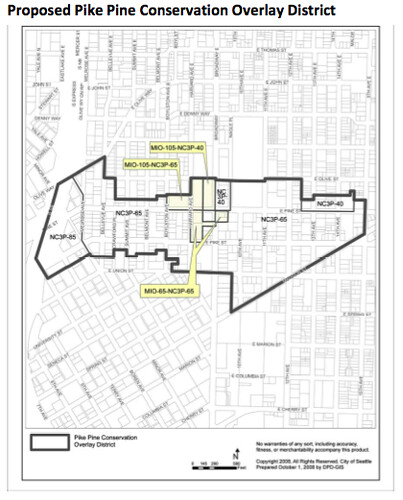
Last week we wrote about City Council Bill 116508’s upcoming public hearing. The city’s Department of Planning and Development is positioning the legislation as the first phase of a zoning overhaul designed to preserve the ‘character’ of the Pike/Pine neighborhood. A spokesperson for Tom Rasmussen, the council member driving much of the city’s work around the plan, described this Wednesday’s 5:30 PM meeting as one of the necessary last steps in the Council’s process before bringing the new rules up for a vote.
So Wednesday’s session will be one of the last opportunities citizens have to provide public testimony on the preservation plan. Expectations for any new issues to emerge are low — the DPD has been meeting with groups in the neighborhood for more than a year. But we were interested to find out what one of the neighborhood’s most active activists thinks about the city’s plan and what he plans to say Wednesday night. Below is Dennis Saxman’s response to the plan. You might know Saxman best for his involvement with the Pine parking lot situation. We don’t endorse, support, embrace or extend his position but it is interesting to see what the neighborhood’s fiercest advocate against development has to say about the Council’s plan.
By Dennis Saxman
Out of a list of over 20 stakeholders proposed to be consulted, only a small percentage had a seat at the table or were consulted at all. The individuals who were most thoroughly canvassed for their opinion were developers with a financial stake in this legislation and condo owners – no renters, no artists, no low-income people, no disabled.
The number of the buildings listed in the ordinance is considerably smaller than the total number of character buildings in the area. A neighborhood with a unified style cannot be preserved if only some of the buildings that reflect that style are included. As an example, look at the buildings going up between 11th and 12th on Pike. If the erection of such buildings, which are incompatible with the existing buildings, continues, the Pike/Pine will lose its identity as a neighborhood. Also, the ordinance provides for the erection of buildings that do not reflect the historic vernacular. If you were to look at other cities – Snohomish is a good example in Washington State – you would see that much greater architectural compatibility is required than is required by this ordinance.
No one at all seems to consider that one factor that makes the Pike/Pine is the extent of the sky and other parts of the neighborhood and City we can see. That will change if all the buildings go to 65-75 feet. This ordinance simply reflects the preferences of a small group of area stakeholders who favor modern design and the attitude of an administration that is not as committed as many other cities around the country to true neighborhood conservation.
I hope the Council will delay a vote on this until they have had the time to more thoroughly investigate what other cities have done. The consultant on the project was originally supposed to do a survey of other cities’ laws, but somehow that fell by the wayside. I have been working with a professor at UW whose classes are and will be studying the Pike/Pine, and I also think the Council would find the results of that study useful before proceeding with this important legislation.



I was interested to find out the other day that the Pike/Pine corridor was the original Auto Dealers District of Seattle, back when cars first came out!
According to the Seattle.gov Department of Neighborhoods:
“The Pike/Pine/Broadway vicinity became Seattle’s Auto Row shortly after the first automobile was offered for sale here in 1905. For the next twenty years virtually all local auto dealers and numerous auto-related businesses were located here. A unique building type was developed for urban auto dealerships. They were fireproof buildings of concrete or brick masonry, with showrooms with large display windows to showcase the merchandise, and driveways to provide auto storage in the rear. Interior ramps or large freight elevators were used to get autos to second floor garages or service areas. Upper floor windows were large, typical of the Chicago school of commercial building design. “
Here is the search tool: http://web1.seattle.gov/dpd/historicalsite/Default.aspx
Some of the buildings now include:
Elysian Brewery, Six Arms, Frame Central, Velo Bikes, Value Village, Victrola, Utrecht, Quinns.
There are tons more! Its really interesting once you start to notice the style; big windows, garage doors. Now it makes sense! Such great history in our own neighborhood!
Why are the pictures on this blog SO SMALL? I can’t see the point in even using photos if they’re too small to see what point you’re trying to illustrate.
Sorry, that picture is ridiculous. I’ll try to find the larger version and replace. In general, the main issue is a tweak we need to make in the system to link to the larger version of images, not the medium size. We’re making that fix. The other problem is how I’ve used the publishing tool. I’m trying to be better about not inserting puny images that are impossible for some to read. Thanks for reminder.